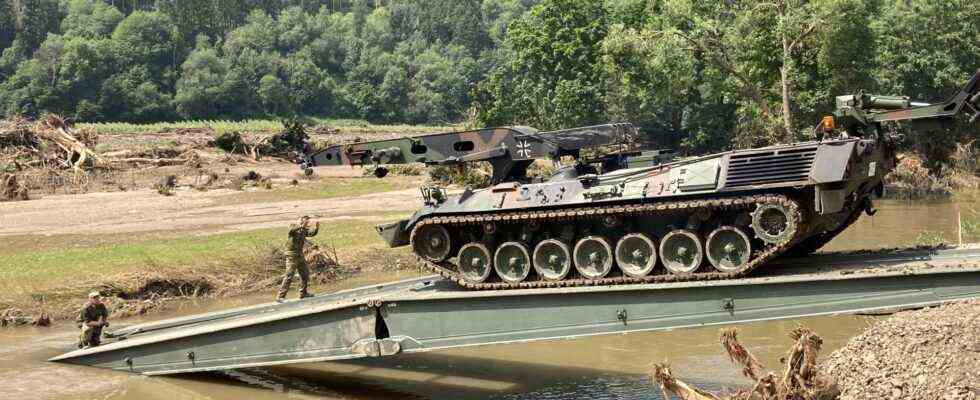Status: 07/21/2021 3:59 a.m.
The federal cabinet wants to bring emergency aid for the regions affected by the flood on the way today. This is intended to finance the first measures and alleviate acute emergencies. But that should only be the beginning.
From Martin Polansky,
ARD capital studio
It will only be a beginning. The federal cabinet plans to provide 200 million euros today to finance emergency aid for the victims of the flood disaster. The countries concerned should add another 200 million euros, according to the cabinet proposal.
When visiting the flood area in Bad Münstereifel, Chancellor Angela Merkel said that it was a matter of working with the state to provide immediate aid in an unbureaucratic manner. “Together we will do everything we can to ensure that the money comes quickly to the people who often have nothing more than what they are wearing and who are therefore dependent on support,” said the Chancellor.
In addition to bridging emergencies, the emergency aid should serve to eliminate direct damage to buildings and municipal infrastructure, says the cabinet proposal from the finance and interior ministries, which the ARD capital studio is present.
Fund for supraregional disasters?
But the real major costs will probably only arise during reconstruction – for roads, bridges or railroad tracks, for destroyed houses or even agricultural areas. The Federal Cabinet wants to decide today in principle to participate in the reconstruction costs. SPD Finance Minister Olaf Scholz spoke of a national dimension in Schönau am Koenigssee on Sunday. “That’s why the whole country has to help,” said Scholz. “Because the destruction that has taken place in some parts of Germany is immense.” If you look at the reconstruction of the infrastructure, it is more like billions.
The federal government wants to talk to the federal states about setting up a fund – for these and future supraregional disasters. The idea may be discussed at a special prime ministerial conference in late July or early August.
Special fund in 2013 of eight billion euros
After the floods on the Elbe and Danube in 2013, the federal and state governments set up a special fund of eight billion euros to finance reconstruction after the floods at the time. Much of the money was also called. Most of the funds flowed into the public infrastructure – such as the transport routes. There was also great demand from private households, affected companies and farms. As a rule, companies were reimbursed 80 percent of the damage. In addition to grants, loan programs were also launched for flood victims, and the deadlines for tax payments were also eased.
The question of how to distinguish between insured and non-insured people regularly causes discussion. According to the insurance industry, 46 percent of buildings in Germany have natural hazard insurance, which also pays for flood damage. Those who are not adequately insured must hope that the authorities and thus the taxpayers will step in in the event of damage.
CDU economic politician Carsten Linnemann is basically in favor of state aid, but it is crucial that in the end those who have insurance for their own house get around better than those who do not, Linnemann told him ARD capital studio. “And then you are welcome to have a debate on the question of whether there will be compulsory insurance in the future or not.”
Million euros in private donations
In 2017, the prime ministers decided in principle to tighten the requirements for emergency aid after floods. In future, applicants should prove that they could only have taken out insurance on unreasonable terms. Some states such as North Rhine-Westphalia or Bavaria changed their state regulations as a result. However, it is election campaign times. Anyone who slows down on aid now is running a great political risk in view of the images of destruction.
In addition to insurance benefits and state aid, private donations also play an important role. “Aktion Deutschland Hilft” has already raised 25 million euros; after the floods in 2013, the association of aid organizations received around 38 million euros in donations. Manuela Roßbach from “Aktion Deutschland Hilft” speaks of a very high level of popularity now. From the flood years of 2002 and 2013, however, we also know how great the need will be in the end – despite state aid. “When people are poor, they must have the same chance of getting a small apartment again or a little house where they can live – like others too,” said Roßbach.
Michael Alten from the Johannitern in Saxony is the flood relief project coordinator. Since the Elbe flood in 2013, Johanniter has financially supported around 1,100 households, associations and small businesses with the reconstruction in Saxony, Thuringia and Saxony-Anhalt. Often it was a question of covering the own share of government aid with donations – so usually 20 percent of the reconstruction costs, says Alten.
Reconstruction will take years
Since the procedures are sometimes very bureaucratic, the last cases were only recently closed. Alten advocates keeping the application forms as understandable as possible. And: The deadlines should not be too short. Because it often takes years before buildings are completely renovated. “We have a shortage of material and also a shortage of skilled workers. So it will not be possible to lend a hand everywhere that quickly.”
The reconstruction is likely to take many years – and the future federal government will probably also be concerned with the aid payments. The 200 million euros in emergency aid from the federal government are just the beginning.
Draft Federal Cabinet for Emergency Flood Aid
Martin Polansky, ARD Berlin, July 20, 2021 7:15 p.m.

